and the distribution of digital products.
State of NEAR Q1 25
- NEAR has reduced the chains' block time to 600ms and 1.2s for finality. The chain also upgraded from six to eight shards in Q1, creating a 33% increase in overall network capacity and introducing single-block resharding, eliminating hour-long state rebuilds.
- The launch of OmniBridge expands NEAR’s interoperability beyond Ethereum, supporting DeFi, AI, and consumer applications across major networks. It improves capital efficiency and positions NEAR as a unified liquidity layer.
- NEAR is building a verifiable AI infrastructure through initiatives like Proof of Response and an RFC for the Agent Interaction & Transaction Protocol. These developments ensure trust, privacy, and autonomous decision-making in onchain AI agents.
- NEAR maintained its market cap ranking of 21st overall, performing similarly to leading assets.NEAR’s market cap ended Q1 at $3 billion, a 47.4% QoQ decrease, with the token price retracing 48.8% QoQ.
- NEAR experienced growth in network usage, with average daily DEX volume rising 101.1% QoQ to $17 million and the stablecoin market cap increasing 2.0% QoQ to $697.2 million.
NEAR Protocol (NEAR) is a smart contract platform that utilizes a Thresholded Proof-of-Stake (PoS) consensus algorithm to execute transactions and aims to provide foundational infrastructure for decentralized applications, AI-powered systems, and cross-chain interoperability. NEAR incorporates the Nightshade 2.0 sharding mechanism, which facilitates increased transaction throughput and scalability by taking a novel approach to basic network functionality and is EVM-compatible via Aurora.
The NEAR ecosystem is expanding chain abstraction across many blockchains and ecosystems, with the goal of abstracting the blockchain away from the end user and developer experience. The vision for chain abstraction is to enable applications to function seamlessly across all blockchains, with effortless onboarding and features like gas fees and bridging becoming invisible to the end users. To achieve this, NEAR is developing the following core building blocks:
- Account Aggregation: A key component of chain abstraction that enables users to manage identities, assets, and transactions across multiple blockchains through a unified experience, eliminating fragmentation and reducing complexity.
- Sharded Blockchain: NEAR, powered by Nightshade 2.0, is designed to support billions of AI-driven interactions with high-speed, low-cost transactions. As of Q1 2025, NEAR operates on eight shards, introducing single-block resharding and eliminating hour-long state rebuilds.
- NEAR Intents: A transaction framework that enables AI agents and users to autonomously execute transactions and requests across Web3, allowing for frictionless, cross-chain interactions without manual oversight. Built on Chain Signatures, NEAR Intents ensure secure, automated execution at scale.
The NEAR Foundation is focusing its efforts and resources on making NEAR the home for User-Owned AI, built on a foundation of a sharded blockchain, chain abstraction, and NEAR Intents. All key innovations that enable AI to operate autonomously, transact seamlessly, and scale securely, helping establish NEAR as the Blockchain for AI. The foundation is investing significant capital and resources in creating the best ecosystem for the development of AI agents, including core AI infrastructure investments through the NEAR Horizon AI Incubator, the NEAR Foundation x Delphi Labs AI Accelerator, and additional R&D efforts through NEAR.AI. Over 50 teams are actively building AI-driven applications, research projects, and tooling on NEAR, laying the groundwork for being a leader in the decentralized AI space.
Website / X (Twitter) / Discord
Key Metrics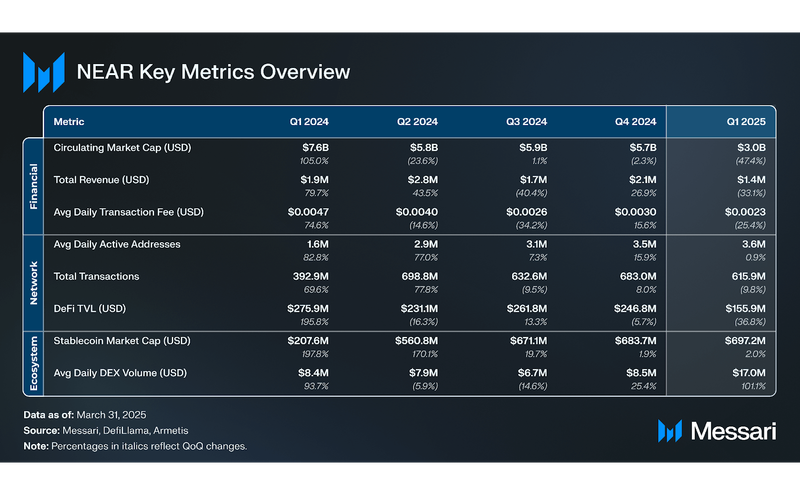 Financial Analysis
Financial Analysis Market Cap and Price
Market Cap and Price
In Q1 2025, NEAR was not immune to the overall market’s downside moves. NEAR ended the quarter with a circulating market cap of $3 billion, a 47.4% QoQ decrease, while the token price also dropped to $2.5, a 48.8% QoQ decrease. Despite the price drop, NEAR maintained its market cap ranking of 21st overall, indicating it performed similarly to other leading assets by quarter’s end.
Revenue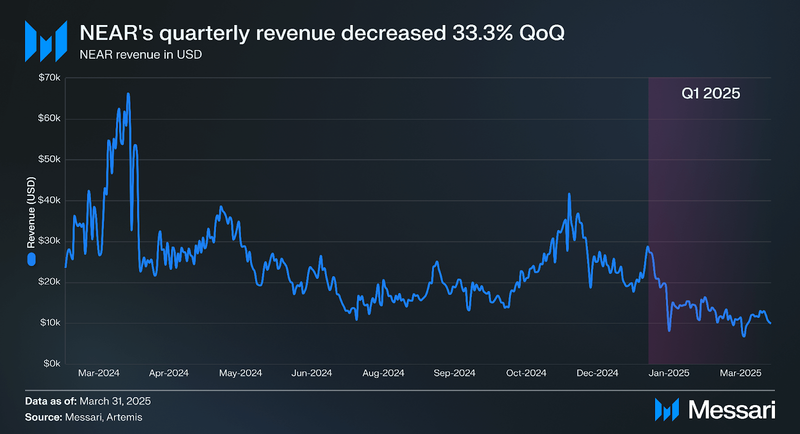
In Q1, NEAR's revenue, which measures network transaction fees but excludes storage staking, decreased to $1.4 million, marking a 33.3% QoQ drop. This decrease can be attributed to the decline in overall transactions and average transaction fees. The average transaction fee in Q1 was $0.0023, a 25.4% QoQ decrease.
NEAR employs a fee-burning mechanism for transaction fees, where 70% of all fees are burned while the remaining 30% is directed to the contract from which the transaction originated.
SupplyNEAR's native token (NEAR) is used for staking, transaction fees, and storage fees. NEAR employs a combination of inflationary and deflationary measures with no fixed token supply. The network follows a fixed annual inflation rate of 5%, with 90% of the inflationary rewards directed toward validators and 10% to the protocol treasury.
Network Analysis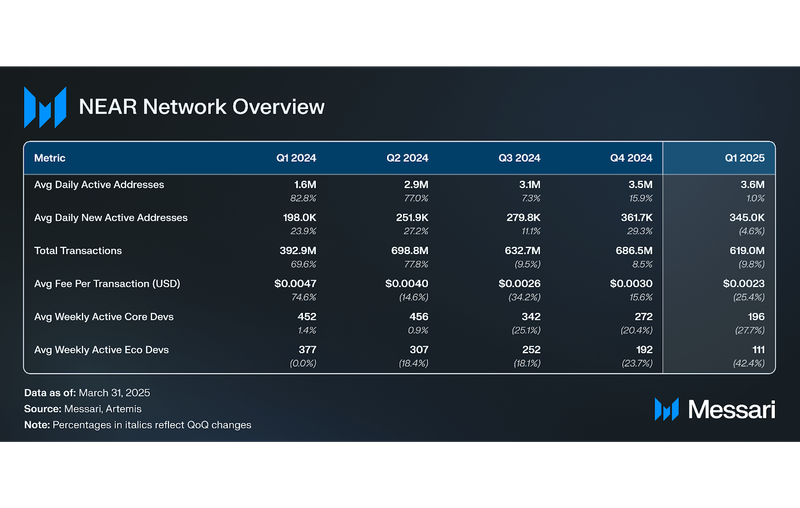 Usage
Usage
NEAR experienced a mix of address activity and transaction volume results in Q1. The average daily active returning addresses increased 0.8% QoQ to 3.8 million; the average daily new addresses decreased 4.7% QoQ to 344,715; and the average daily transactions decreased 7.8% QoQ to 6.8 million.
Development
NEAR experienced a continued decline in its weekly active core developers, which decreased by 27.7% QoQ from 272 to 196, while weekly active ecosystem developers decreased by 42.4% QoQ from 192 to 111.
NEAR places an emphasis on supporting developers, with 30% of transaction fees distributed to the creators of the smart contract called by a given transaction. In addition to this fee structure, NEAR offers an extensive suite of tools tailored for developers working within its ecosystem. These include SDKs for popular coding languages, sandbox environments, a NEAR CLI, and NEAR Developer Governance. The NEAR Dev Hub serves as a resource repository for developers, facilitating collaboration and innovation within the ecosystem. Early successes include sponsored hackathons, the formation of community groups, and collaboration on NEAR Enhancement Proposals.
NEAR.ai is the launchpad for developers building in the crypto x AI space to gain exposure to the infrastructure and tools NEAR has developed. With two projects, AI Research Hub and AI Assistant, NEAR is showing the developer community why it is the blockchain for AI. Over 940 NEAR agents have been deployed and can be viewed on the developer hub.
Additional development activities in Q1 2025 included:
- NEAR Dev, launched on February 3, 2025, is an independent entity aimed at supporting application developers and partners within the NEAR ecosystem. NEAR Dev will operate alongside DevHub, which has been facilitating community-driven development efforts. While DevHub remains focused on developer tooling and community contributions, NEAR Dev is structured as a formal entity with a team specializing in technical consulting, development tools, and developer relations. To stay updated, sign up for the NEAR Dev Hub newsletter.
- Nearcore v2.5.0, released on March 4, 2025, introduced protocol upgrades like Resharding V3, which implements a new resharding mechanism, two new shard layouts, and a cross-shard bandwidth scheduler to improve receipt transfers and scalability. The state sync process has also been modified to delay the start until a few blocks into the epoch, and transaction validation has been parallelized to enhance processing efficiency. Shard identifiers are now arbitrary and no longer sequential.
- Nearcore v2.5.1, released on March 6, 2025, included a fix for an issue where validators were missing chunks. There are no protocol changes beyond those in v2.5.0.
- In Q1, NEAR awarded over $40,000 in protocol rewards to participating projects. Projects can apply to participate in this program, which is evaluated using different metrics, such as project potential, technical skills, and community engagement.
- NEAR has upgraded the chain to have a 600ms block time and 1.2s finality. This enhancement was made possible due to an optimization the NEAR team implemented that reduced block latency by 2x, meaning that the current block time of 1.1s can be reduced to 600ms. The team has done extensive testing to ensure the reliability of this new block time and finality.
NEAR employs a Thresholded Proof-of-Stake (TPoS) consensus mechanism with three distinct validator roles: Block Producers, who are responsible for validating transactions across all shards; Chunk-Only Producers, who focus on individual shards with reduced hardware requirements; and Hidden Validators, who act as independent third-party monitors.
The implementation of Nightshade sharding began with Phase-1 in September 2022, enhancing the network's capacity to support Chunk-Only Producers. By Q1 2024, NEAR launched Phase-2 of Nightshade sharding with six shards operational on mainnet, progressing towards the plan to expand to 100 shards. Q1 2024 also saw the launch of the Enterprise Node Operators program by Meta Pool in partnership with the NEAR Foundation, which started onboarding leading institutions into the ecosystem, including Deutsche Telekom and NTT DATA. Stateless Validation, also known as Nightshade 2.0, launched on mainnet on August 22, 2024. This upgrade improved throughput for each shard by 5x and increased the total number of shards available for the network. On March 23, 2025, NEAR was upgraded from six to eight shards, creating a 33% increase in overall network capacity.
By the end of Q1 2025, NEAR had 254 active validators and 44.9% of eligible supply staked.
Additional security-related updates in Q1 included:
- The Professional Node Operators (PNO) Program was launched in collaboration with Meta Pool. This program will expand the validator set on NEAR, with ten new validators already announced.
- Ledger Live now allows users to swap NEAR in their application.
- Nansen added NEAR token staking to its services.
Building off the House of Stake governance proposal from Q2 2024, the Gauntlet partnership continues to advance the governance structure of NEAR. House of Stake is a permissionless, stake-weighted voting system with goals that include supporting ecosystem growth, responsibly deploying the HoS treasury, improving network economics, increasing network security, and improving quality of life for validators.
On December 5, 2024, Gauntlet announced the NEAR Call for Delegates proposal, asking individuals to apply to become Endorsed Delegates in the House of Stake. The application window was closed on February 16, 2025. The NEAR Foundation reviewed all the delegate applications and announced its selection of the first 11 Endorsed Delegates during an X space. NEAR also recently announced a partnership with Agora to build the House of Stake frontend, which is expected to go live with delegate voting in Q2 2025.
The next phase of House of Stake involves the creation of multiple autonomous AI agent delegates that will participate directly in governance, with an eye towards reducing the burden on human governors and only requiring humans in the loop for certain critical decisions.
Ecosystem Analysis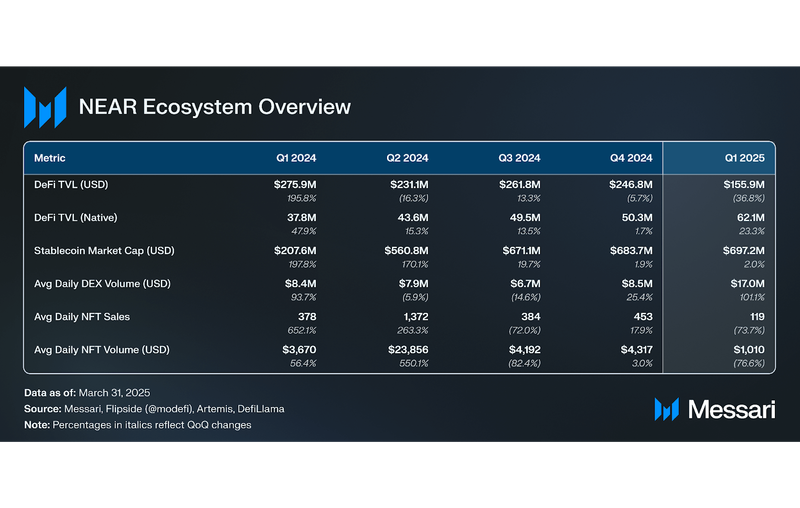 DeFi
DeFi
NEAR's DeFi TVL in USD ended Q1 at $155.9 million, reflecting a 36.8% decrease from the previous quarter. The DeFi TVL in NEAR ended Q1 up 23.3% to 62.1 million.
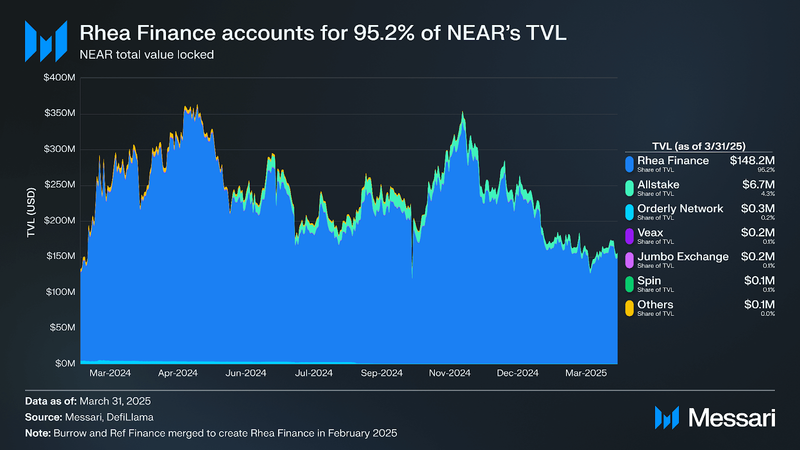
In Q1, the landscape of players who contributed to NEAR’s TVL was shaken up compared to last quarter. Burrow and Ref Finance merged into Rhea Finance and now account for 95.2% of NEAR’s TVL, at $148.2 million, down 35.9% QoQ. Allstake, which launched on June 20, 2024, finished Q1 with $6.7 million in TVL, a decrease of 52.2% QoQ.
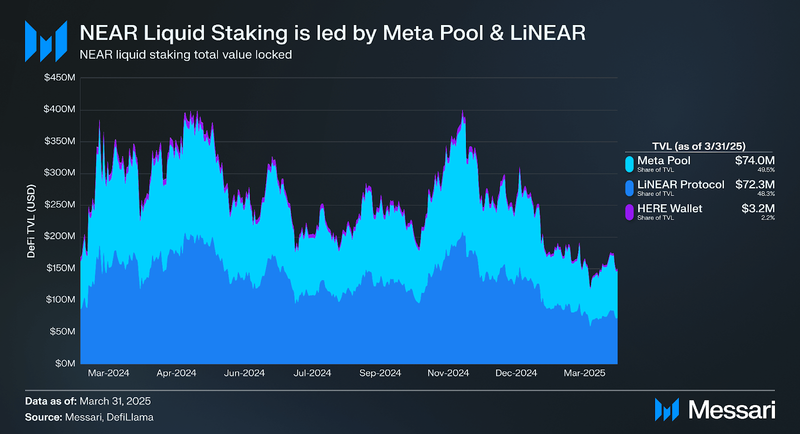
In Q1, NEAR’s Liquid Staking TVL decreased 40.4% QoQ to $149.6 million. LiNEAR Protocol had a TVL of $72.3 million, reflecting a 45.4% QoQ decrease, while Meta Pool had $74 million, showing a 33.7% QoQ decrease.
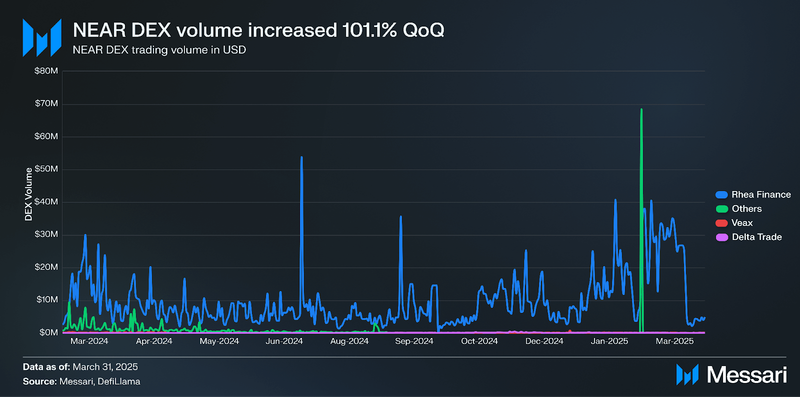
Throughout the quarter, NEAR had an average daily DEX volume of $17 million, reflecting a 101.1% increase from the previous quarter. Rhea Finance remains the leading DEX by volume on NEAR, with an average daily volume of $16.2 million.
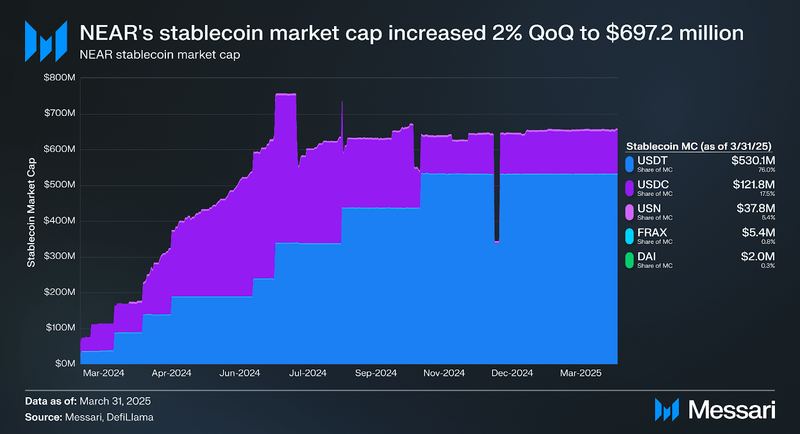
In Q1, NEAR’s stablecoin market cap increased 2% QOQ, reaching $697.2 million.
Additional Ecosystem activities in Q1:
- Users can now trade NEAR directly in the Telegram wallet.
NEAR’s User-Owned AI initiative is a leader in integrating artificial intelligence with blockchain technology. This effort focuses on democratizing AI development, ensuring user control over data and assets, and fostering a decentralized framework for AI applications. Central to this effort is the concept of chain abstraction, which makes NEAR Intents possible, allowing AI to autonomously execute cross-chain transactions and requests across both Web2 and Web3, breaking down silos and enabling seamless operations for AI agents and related business models. Meanwhile, the sharded NEAR blockchain provides scalable, low-cost blockchain infrastructure that is built to handle large magnitudes of AI transactions. The development of the NEAR AI Assistant and AI Research Hub aims to support easier development through AI-driven platforms.
In Q1, Laser Digital Asset Management launched a NEAR Adoption Fund for Institutional Investors. One of the main drivers for this fund offering is due to NEAR's focus on User-Owned AI and building toward the AI-enabled world.
Proof of ResponseProof of Response (PoR) is a cryptographic protocol developed by NEAR AI that allows anyone to verify that a specific AI model generated a particular output in response to a given input, without needing to rerun the model. This is achieved through a combination of verifiable inference techniques and cryptographic commitments. Unlike traditional approaches that rely on trusting centralized model providers, PoR introduces a way to confirm AI responses in a decentralized, trust-minimized manner. This is especially important for onchain AI agents that require transparency and verifiability when executing tasks or making decisions.
From a technical standpoint, PoR can be integrated with zero-knowledge proofs (ZKPs) or multi-party computation (MPC) frameworks to ensure that both the model’s integrity and the computation process remain tamper-proof. This enables onchain agents to sign and verify responses with cryptographic assurance, making it possible to build applications that use AI outputs in smart contracts, governance decisions, or financial logic. By enabling verifiable AI execution onchain, PoR supports the broader vision of decentralized AI infrastructure, where models become accountable actors in the blockchain ecosystem. For a more in-depth look at PoR and Decentralized Confidential Machine Learning, reference this research paper by the NEAR AI team.
Other notable AI events in Q1 included:
- On February 20, 2025, NEAR launched Shade Agents, autonomous AI agents built on NEAR that can independently interact with blockchains. Shade Agents can execute transactions, hold assets, and make decisions without needing human oversight. By combining smart contracts with secure key management, Shade Agents represent a major step toward a decentralized AI economy where software can act as fully independent economic participants. An example use case of Shade Agents is Based Names Agent, which is a non-custodial, autonomous agent that lets users claim a basename with a tweet.
- NEAR AI released an MCP Integration enabling the ability to spin up wallets, send and receive, deploy and monitor decentralized applications, run strategies, and manage onchain operations. Further development will include smart contract function calls via natural language, full Intents support for cross-chain flows, and integration into the NEAR AI API stack.
- NEAR AI also announced the creation of the open agent alliance, OAA, with 20+ members like Coinbase, Phala, ElizaOS, and Frax Finance. The mission of the OAA is to share a commitment to make the future of AI agents and assistants open, user-owned, and globally available to all while fairly rewarding its builders.
- NEAR AI and Phala launched a Private ML SDK built with TEEs. This SDK marks a step toward creating a user-owned AI future with the proper privacy-enabled foundation. Soon, every agent in the NEAR AI Hub will run verifiable private execution powered by this SDK. For more information, see the full announcement.
- On February 26, NEAR AI, in collaboration with ElizoOS, provided all agents built using that technology stack the ability to integrate with NEAR AI. This allows agents to be multichain.
- On February 25, 2025, NEAR AI published an RFC for the Agent Interaction & Transaction Protocol (AITP), outlining a draft specification, inviting community feedback, integrating AITP into the NEAR AI Hub, and building compatible agents to refine the protocol before its 1.0 release. By establishing a universal, secure “HTTP of agents” that enables AI assistants and decentralized agents to communicate, negotiate, and transact across trust boundaries, whether in fiat or crypto, AITP envisions an Internet of Agents that creates new business models and reshapes online interactions and commerce.
- As outlined in the Q4 2024 report, the NEAR Infrastructure Committee's priority list for 2025 included wallet enhancements. On March 28, 2025, the Committee announced the winners of the RFP related to wallet enhancements. The Wallet Selector was won jointly by Lucis and Hot Wallet and will serve as an open-source public good for a unified interface that aggregates NEAR’s wallet ecosystem. Multichain 1-Click Connect and Multichain Fast Auth were won by Peersyst Labs and aim to create a completely embeddable wallet that is compatible with major wallet providers across all chains.
- NEAR's integration of AI has not gone unnoticed in the broader tech industry. NEAR Protocol Co-Founder Illia Polosukhin spoke at Nvidia's GPU Technology Conference (GTC) in March. He gave a presentation titled "Confidential and Verifiable AI Computing: Ensure Trust, Privacy, and User Ownership in AI Systems," which discussed new research from NEAR AI on the technical basis for an AI economy.
- Prior to his presentation, Illia released the first version of the Decentralized Confidential Machine Learning research paper. This paper introduces a new approach to training, fine-tuning, and deploying models and agents that also creates a sustainable business model for developers and researchers.
- Sweat Economy is launching a personalized AI Agent built on the NEAR AI technology stack and will launch it to its 20+ million users.
- Hackathons:
- In January 2025, NEAR hosted the One Trillion Agents Hackathon, which offered over $100,000 in prizes and had 2,000+ participants. Explore the full list of hackathon winners of the various tracks here.
- The Zcash x NEAR Intents Hackathon offered $70,000 in prizes and challenged participants to create applications that leverage the strengths of both Zcash and NEAR Protocol. This hackathon focuses on key areas such as AI agents, private DeFi, and cross-chain interoperability, encouraging the development of censorship-resistant and decentralized financial systems.
- In February 2025, NEAR sponsored a hackathon in collaboration with Coinbase Developer Platform, Replit, and Anthropic. The goal for the 100+ participants was to create agents that could understand and analyze complex data and explain their decisions. NEAR selected two winning projects: Chainsmokers, an MCP-augmented chatbot by Matthew Law, and Mosaia, a smart wallet agent by Aaron Wong Ellis, Alex Alksne, and Cyril Delattre.
- In March 2025, NEAR AI hosted the Useful Agents Hackathon in SF in collaboration with SF Compute and Electric Capital. Over 100 developers participated in a 24-hour sprint, with the goal of building agents that tackle real issues with quantifiable, repeatable results. With a $20,000 prize pool, three winners were crowned. In first place was Zahidul Islam and team, who made Postt, an AI-powered social media manager tailored specifically for startup founders and professionals focused on personal branding and thought leadership. In second place was Vijay Sithambaram and team, who made DiligenceAI, a multi-agent system that performs comprehensive due diligence on potential investments. In third place was Nelson Lai, who made NEAR Food, an agent that finds free food events while effectively navigating anti-bot measures that typically prevent such automation.
Building off the successful launch of Chain Signatures, which enables NEAR accounts, including smart contracts, to sign transactions on various blockchains, effectively eliminating the need for traditional bridges, NEAR has taken the first steps to realizing a full chain-abstracted future.
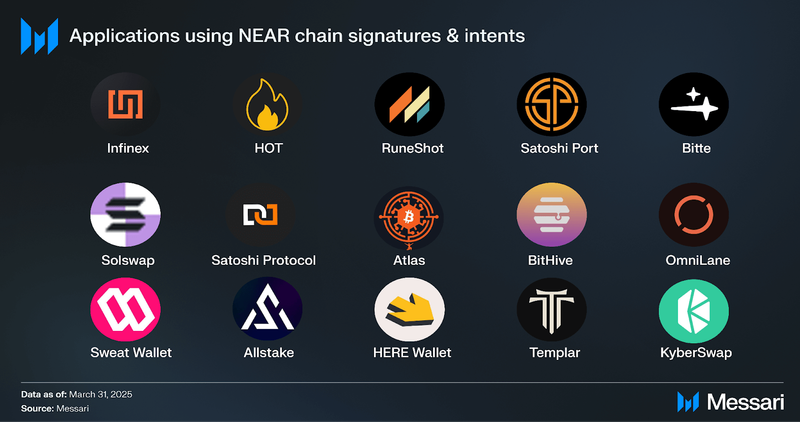
Several applications already utilize Chain Signatures and Intents on NEAR's mainnet, including the Sweat Wallet, which allows over 2.5 million active users to bridge assets to/from various blockchains. Allstake, an omnichain restaking protocol, utilizes Chain Signatures for cross-chain state synchronization, enabling users to restake assets across NEAR, Solana, Ethereum, and Bitcoin. HERE Wallet and Bitte Wallet are also leveraging Chain Signatures to offer multichain experiences, with Bitte Wallet enabling passkey wallets for any network, including Bitcoin. Hot Protocol has had 21+ million wallets created, powered by chain signatures and NEAR Intents to provide users a seamless experience swapping across chains. Both Chain Signatures and NEAR Intents have open SDKs that developers can use to integrate into their own applications.
In Q1, the NEAR One team launched OmniBridge, utilizing Chain Signatures, to enhance NEAR's cross-chain interoperability and facilitate transactions and liquidity across multiple blockchain networks. OmniBridge expands NEAR’s interoperability beyond the Ethereum-focused Rainbow Bridge, with the aim of establishing NEAR as a unified liquidity hub while improving capital efficiency and reducing fragmentation. OmniBridge, an open-source architecture, empowers developers to build interoperable DeFi, AI, and consumer applications across major blockchain ecosystems.
Intents have also been heavily developed and productized by the NEAR team and used by outside companies like Infinex. Infinex is a new take on what a crypto app for everyday users should look and feel like. By utilizing parts of the NEAR technology stack, like Intents, Infinex is able to offer users the ability to store, swap, send, and receive tokens on various EVM and Solana networks while also not needing to sign transactions or worry about their seed phrases.
NEAR Intents is a live application that enables users to swap assets seamlessly across different networks. It leverages a spot DEX and Chain Signatures to facilitate these cross-network trades securely. On February 8, NEAR announced the integration of Zcash on NEAR Intents. On March 5, 2025, KyberSwap's announced the integration of NEAR Intents into its platform. This collaboration allows users to trade assets like BTC, ETH, USDC, USDT, DOGE, and NEAR without the need for bridging, enhancing the user experience and expanding KyberSwap's aggregation capabilities beyond the EVM ecosystem.
Development activities in Q1 around Intents:
- NEAR launched passkeys for seamless authentication, eliminating the need for traditional seed phrases and making access to digital assets more secure and user-friendly.
- NEAR added the functionality of OTC trading, which does not rely on traditional exchange pricing mechanisms. This enables peer-to-peer transactions at fixed prices with known counterparties, bypassing traditional exchange rates. Once a deal is agreed upon, NEAR Intents ensures a trustless and seamless settlement.
- Users are able to create a shareable gift link for crypto transfers.
- NEAR launched a 1-Click API for intents, allowing users to perform cross-chain token swaps by sending tokens to a provided deposit address, triggering automatic execution in a single action.
During the rest of 2025, the NEAR team plans to continue development on Chain Signatures to increase throughput and reduce latency.
 Nightshade 2.0
Nightshade 2.0 Nightshade 2.0 represents a significant advancement in NEAR’s sharding architecture and introduces stateless validation. A concept popularized by Vitalik Buterin, stateless validation allows validators to confirm transactions without storing the entire blockchain state locally and retrieve the necessary state information directly from the network, reducing resource requirements and operational costs, in addition to eliminating the need to maintain local shard states.
Nightshade 2.0 bolsters NEAR’s capacity to handle a growing number of users and transactions by an estimated 400.0% increase in transaction execution speed. The reduced operational costs lower barriers to entry for validators while enhancing decentralization and security. Improved performance through faster transaction execution is crucial for supporting high-demand applications in DeFi and emerging use cases like User-Owned AI. Nightshade 2.0 lays the foundation for integrating future technologies, including dynamic re-sharding, further gas cost reductions, and optimized state witness sizes.
Where Nightshade 2.0 goes from here:
2025+
- Addition of a transaction priority fee.
- Dynamic resharding to increase efficiency when a shard is overloaded or underutilized.
- Runtime performance improvements (still in the idea stage).
- Faster block times.
- Addition of leaderless consensus.
- Addition of sharded smart contracts to help with scalability.
In Q1 2025, NEAR demonstrated significant strides in ecosystem growth, technical advancements, and strategic initiatives despite facing negative market challenges. While its market cap and token price experienced declines, the network’s fundamentals showed resilience, with increased DEX volume, address activity, and stablecoin adoption.
NEAR’s ongoing initiatives like Chain Signatures, NEAR Intents, and User-Owned AI underscore its commitment to scalability, interoperability, and decentralized innovation. As NEAR advances through 2025, its priorities include enhancing infrastructure through OmniBridge and passkey-enabled wallets, simplifying cross-chain UX with Intents and 1-Click APIs, and accelerating the development of verifiable, autonomous AI agents. With a strong focus onchain abstraction, open-source tooling, and community-driven governance, NEAR is establishing the foundation for a future where AI, DeFi, and multichain applications thrive in a seamless, trust-minimized environment.
- Home
- About Us
- Write For Us / Submit Content
- Advertising And Affiliates
- Feeds And Syndication
- Contact Us
- Login
- Privacy
All Rights Reserved. Copyright , Central Coast Communications, Inc.